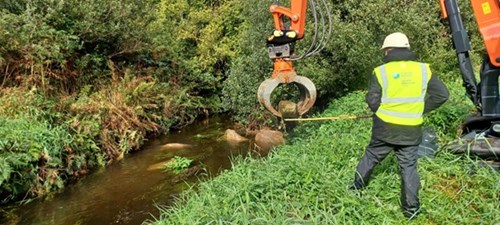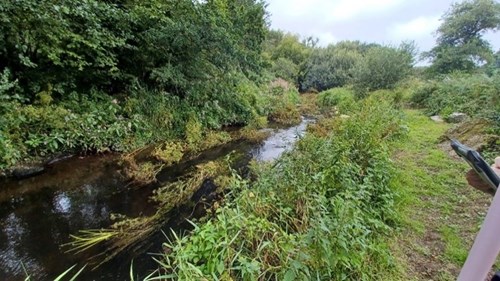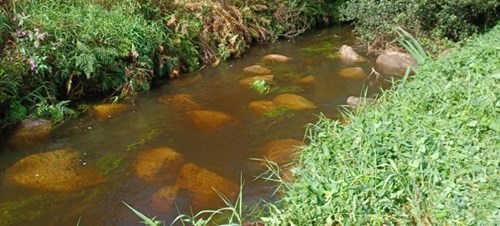How can boulders restore rivers?

The Four Rivers for LIFE project is tasked with improving the habitat structure and function of the four SAC Rivers; Teifi, Tywi, Cleddau and Usk.
In late autumn 2023, a river habitat restoration project began on the Western Cleddau in Pembrokeshire.
The project re-introduced boulders into the river channel to create a more diverse habitat and restore natural river processes.
In this blog, Four Rivers for LIFE River Restoration Officer, Duncan Dumbreck talks about this work and how it will make a difference.
Looking back – what happened and why?
Parts of the Western Cleddau River flow close to Letterston village in Pembrokeshire and when surveying the area in 2022 large boulders were found along the riverbank.
The boulders are believed to have been removed from the river as part of historic dredging in the late 1960s. This was confirmed by the presence of similar types and sizes of boulders found nearby. These boulders showed clear signs of weathering and erosion as opposed to bank protection boulders, which are quarried and angular in shape.
The boulders in this stretch of river were originally deposited here by glaciers most likely during the last ice age.
They were clustered together in this reach and influenced the river and its processes upstream of the location until their removal.
Removing the boulders destabilised the riverbed, causing the finer gravels to be eroded and transported downstream when the river was in flood.
As a result, the riverbed dropped, creating a new channel shape based on the available sediment supply and flow. This would have drastically changed the habitat complexity and availability.
How will boulders help the river?
Whilst rivers have a remarkable ability to self-restore, this can be a very slow process and is dependent on the amount of gravel being supplied and the energy to move them.
The river on this stretch doesn’t have the energy available to move the boulders on its own, and so at this site the project chose to return the boulders to the river to assist natural recovery and create more habitat complexity.
The boulders were returned to the channel using long reach machinery (see image below).

As the first boulder was placed back into the river channel there is an immediate effect. Water that was previously able to flow freely down the river now has to negotiate its way around or over the boulder.
This creates flow diversity, water speeds up on either side of the boulder and slows down upstream and downstream.
Boulders will create habitat for wildlife
As more boulders are returned, we see more change as the flow is affected by combinations of multiple boulders.
These different flow types create habitats for different insects which are part of the food chain that keeps species like salmon and otters happy.
The flow shadows (a subtle area of slack water downstream of the boulders) are well used by fish as rest areas, as they move up and down stream and swim from boulder to boulder to save their energy.
Boulders can help move gravel, sand and silt
The difference in flow speeds will also influence the way the river carries gravel, sand and silt.
The river naturally sorts these different sediment sizes into bedforms (the ripples and dunes on the bed of a river).
By grouping boulders in different ways, we can encourage the river to form different flow and habitat types, increasing the number of different habitat types in that stretch of river.
Most of these effects are minimal in low flow conditions, but as soon as the river starts to rise, it starts to pick up gravel and sand, transporting these sediments down river and depositing them in lower energy areas.
What next for the Cleddau River?
Shortly after work was completed there was heavy rainfall and the boulders themselves disappeared beneath the surface of the water, but the change in the flow was still clearly visible.
Previous surveys of fish and aquatic insects have found a mix of trout, lamprey, bullhead and stickleback in this part of the river.
This regenerated habitat will be vital to the survival of species like salmon, which are at risk of becoming extinct in some rivers in Wales.
Habitat recovery is a very slow process and can take hundreds of years. This work will boost the recovery process by using methods that would naturally occur.
We’re looking forward to getting back on site in the spring to monitor the impact of the work.
Before: section of river targeted for boulder reintroduction

After: boulders re-introduced into the river

To keep up to date with our work, you can follow us on as Facebook, X (previously Twitter) and Instagram or subscribe to our newsletter.
